Focus, or concentration, is the ability to give your full attention to something. It sounds simple, but anyone living in the 21st Century is likely to tell you that it’s not always that easy.
Distractions come from all directions. Whether it’s in the form of technology, social diversions, or any other type of inside or outside disturbance. The ability to stay focused can be easily deterred. And once your concentration is broken, it can take a while to get back on track.
Being able to focus on demand isn’t impossible. And you won’t need someone swinging a pendulum and reminding you to “focus, focus, focus” as you watch it swinging hypnotically before your eyes. Just a few tips to help you eliminate distractions and create some helpful habits may do the trick!
Benefits of Staying Focused
Where you focus your attention is where you place your energy. When you are distracted by too many things, your focus becomes fragmented and your energy is divided. If doing top level work is your goal, then focusing your energy on one thing can be a huge asset.
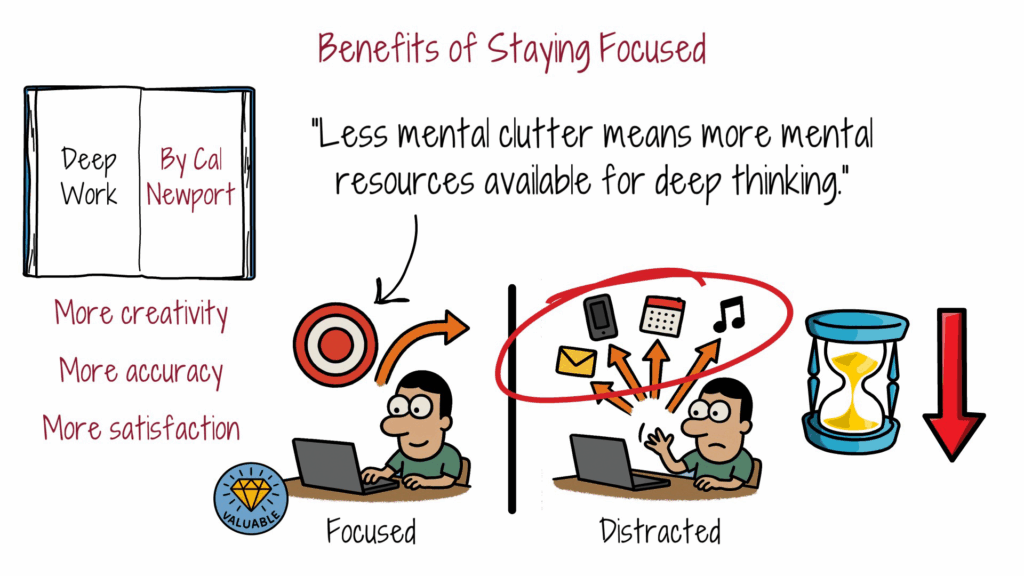
In his book Deep Work, author Cal Newport writes,
“Less mental clutter means more mental resources available for deep thinking.”
When you work on a single task without distractions, you can achieve the flow state that increases better productivity.
Spending less time on outside distractions also helps you to get things done. Making the best use of your time while being focused on the task at hand can lead to more creativity, accuracy, and overall satisfaction with the work you’re doing.
Staying focused can also help us to stay present, and being present can help when making decisions and promoting mindfulness. When you’re fully present you are less likely to make errors. For example, how many times have you left the house with things on your mind, and later wondered if you remembered to lock the door or turn the coffee pot off? Staying focused and present helps you to do what you need to do with full awareness.
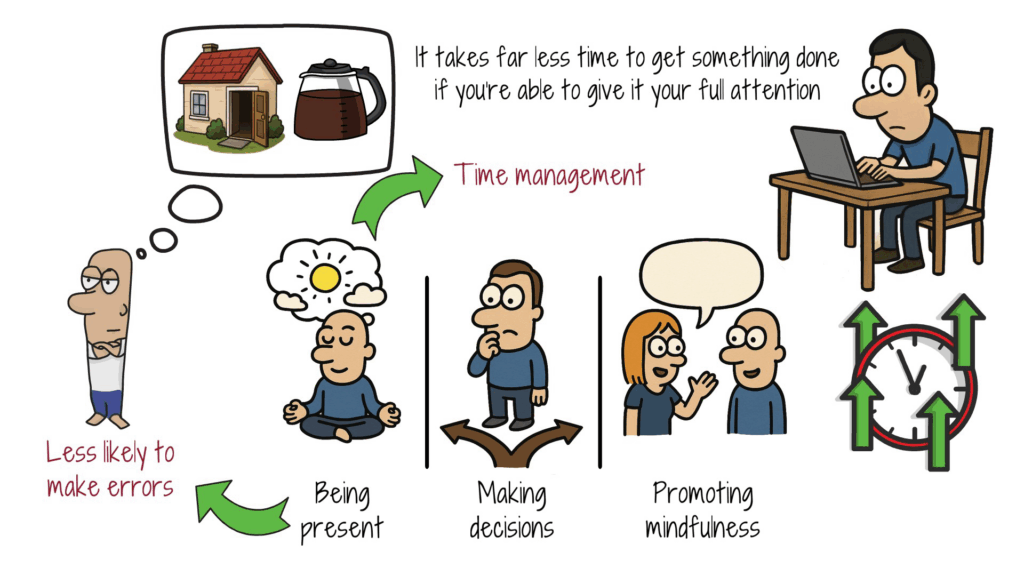
Staying focused also helps with time management. It takes far less time to get something done if you’re able to give it your full attention. When you assign blocks of time for specific tasks, and do each one with your complete focus, you can achieve quality work in less time.
Create the Space
One habit to help you focus is creating a distraction free space where you can think and not be interrupted. A clear and quiet zone can promote a successful work area. For example, unclutter your work space by eliminating other projects from your immediate view. Putting paperwork in drawers and clearing your desk of unnecessary items can help you focus on what you’re doing, without being reminded or tempted by visual distractions.
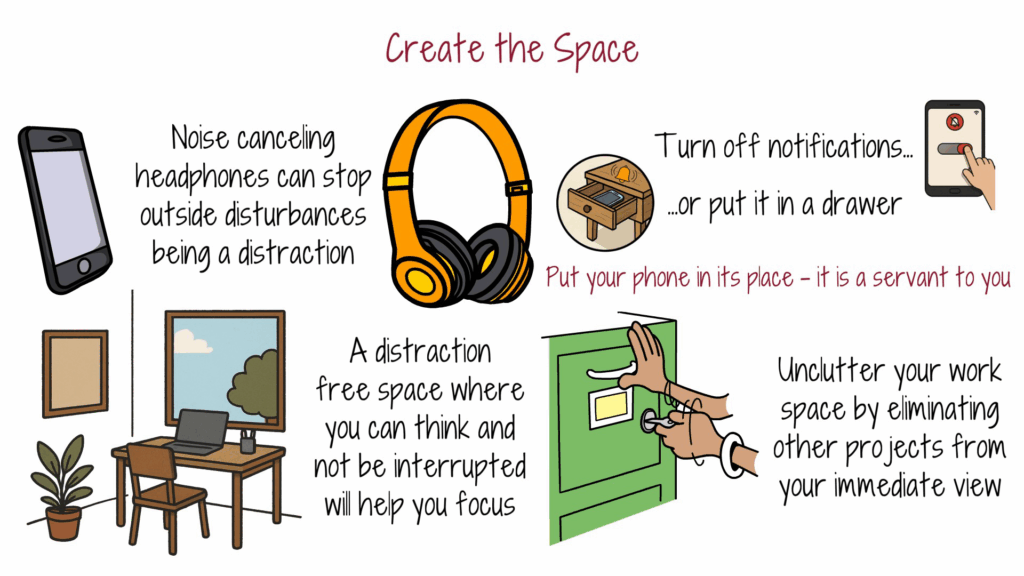
If outside disturbances are a distraction, using things like noise canceling headphones might be one solution. Other common distractions are our phones. Remember that your smartphone is a tool. If you need to make a call, connect with someone through a text or email, or look something up on the internet for information, then use it. If not, leave it alone.
Turn off notifications and place it face down on the desk. Or better yet, put it in a drawer. Your phone is at your disposal to provide a service. You are not at the disposal of your phone. You do not need to answer or pay attention to it every time it rings, dings or summons you. Put your phone in its place – it is a servant to you – not the other way around.
Tools and Rules
Once you’ve created a clear and calming space, making good use of your time can be the next step to boosting your ability to focus quickly. The Pomodoro technique is a well known way to help you to develop a work/break plan for best efficiency.
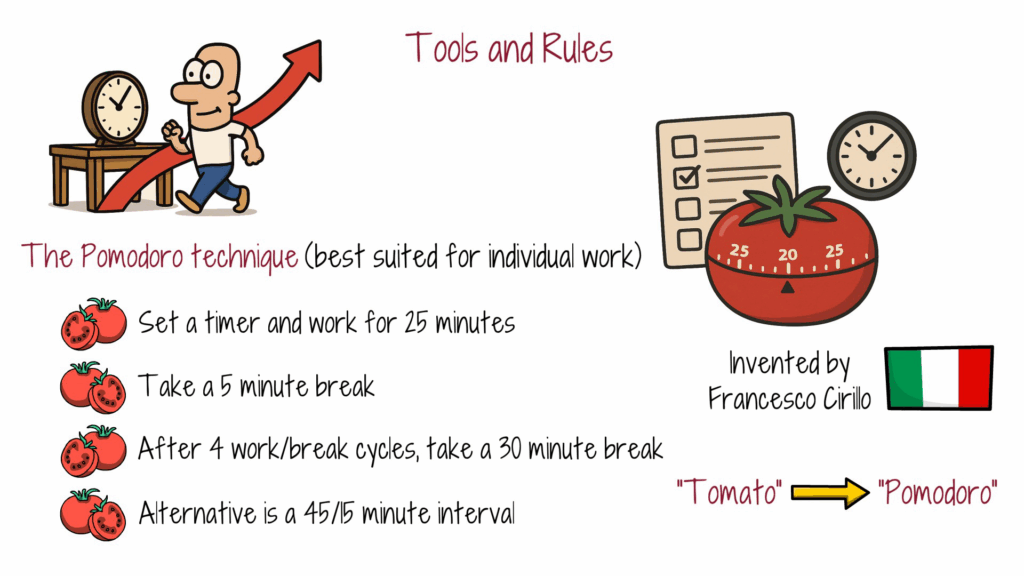
This method involves setting a timer for 25 minutes and focusing on your project for that amount of time without distractions. Then take a 5 minute break. After 4 work/break cycles, take a 30 minute break. If it’s hard to refocus with a 25/5 interval, try changing the intervals to a 45 minute work time and a 15 minute break. Whichever works best for you. This technique is best suited for individual work where you can control the number of distractions.
As a fun fact, Pomodoro is not the name of the person who discovered this method. The inventor of this technique is Francesco Cirillo from Italy. He first used a red colored, tomato shaped kitchen timer to time his sessions, and the Italian word for “tomato” is Pomodoro.
When looking for tools to use in your workspace, sometimes the less complicated answer is to use something you already have.
Setting the stage before you begin work can make a big difference in how quickly you can focus your attention. If you enter your work cycle by reducing all clutter, including the random thoughts in your head, before you begin, you may find it easier to go directly into the focused state.
Use techniques like breathing or meditation to calm the “monkey mind” that draws your attention away to other things. When your brain is jumping from one thing to another, like a monkey swinging from tree to tree, you will need to find a way to bring it down to one focused thought. Take several deep breaths and then be mindful of your regular in and out breathing pattern. This can help to disconnect from outside disturbances. Continue to breathe and let go of conscious thoughts for at least 5 minutes.
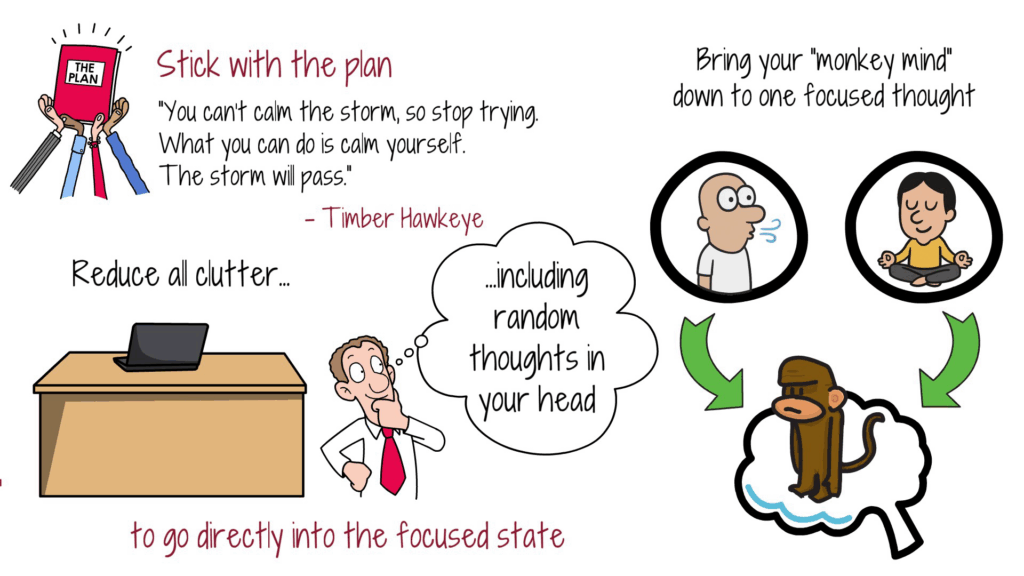
Finally, once you’ve developed a plan, stick with it. If you’re having trouble doing that, don’t blame the distractions, improve your focus. Author Timber Hawkeye wrote,
“You can’t calm the storm, so stop trying. What you can do is calm yourself. The storm will pass.”
Then you can direct your focus.
Music and Apps
Some people have better success focusing when it’s not completely silent. A quiet space can still be effective when playing soft background music without lyrics. This form of sound can allow our minds to relax and promote flow and creativity.
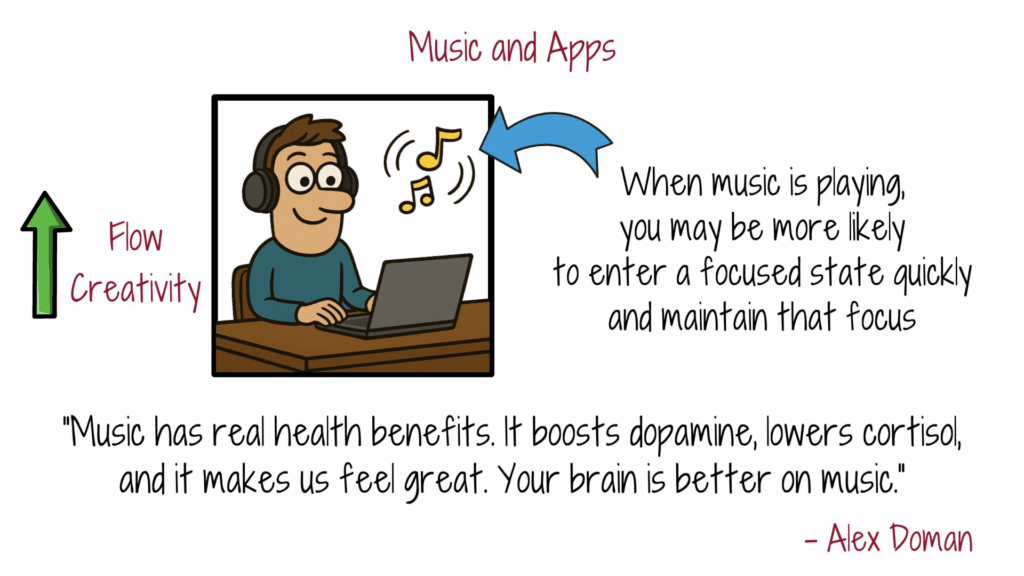
Alex Doman, writer and founder of Advanced Brain Technologies said,
“Music has real health benefits. It boosts dopamine, lowers cortisol, and it makes us feel great. Your brain is better on music.”
When music is playing, you may be more likely to enter a focused state quickly and maintain that focus.
Apps that help eliminate distractions and block notifications for a predetermined period of time can also be helpful. The Forest app is one example. With this app, you plant seeds that grow into trees when you’re not looking at your phone. You actually get warnings that you’re putting your trees at risk if you stare at the screen too long. Doing well earns in-game coins that you can donate to plant actual real world trees.
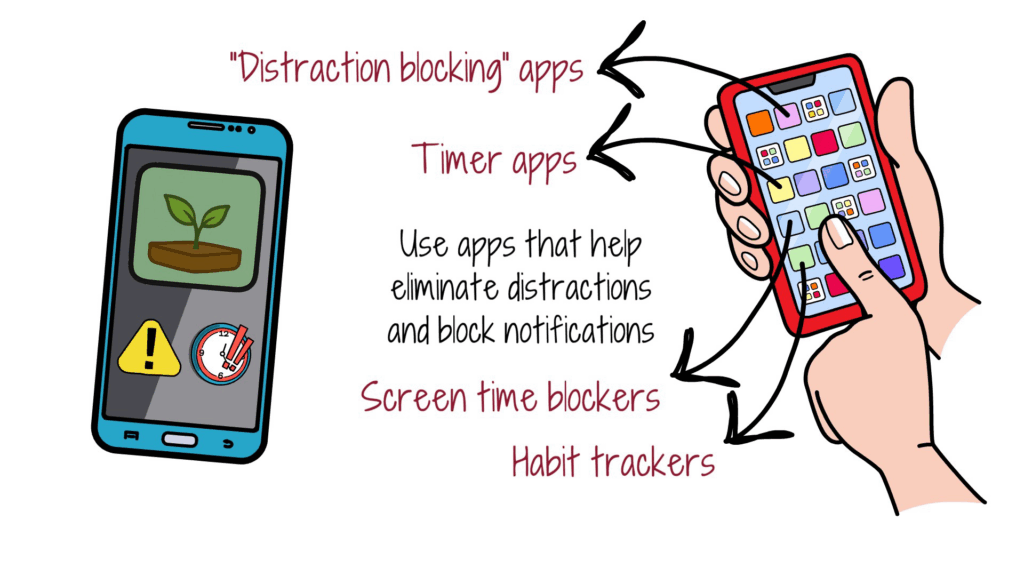
Using apps that create “distraction blocking” scenarios can be useful and fun. Other popular apps are timer apps that you could use to monitor your work/break cycles, as well as screen time blockers and habit trackers. The makers of these apps want you to use them, so they make them entertaining in a way that benefits you.
Eat, Sleep and Exercise
Being at your best physically, will make focusing easier. The same ideas that make other parts of your life work better also work with focus and concentration.
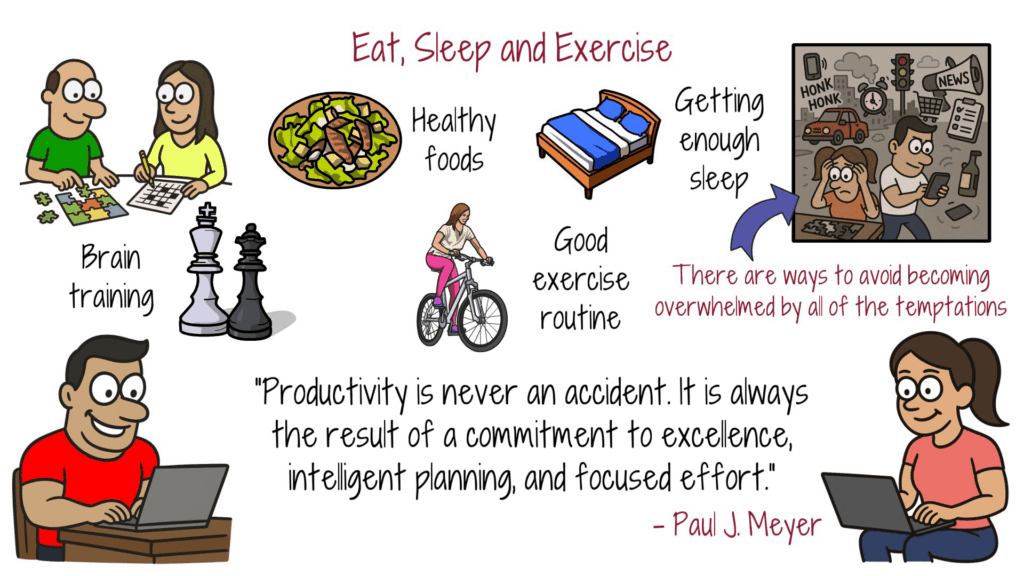
Eating healthy foods, getting enough restful sleep, and having a good exercise routine will all contribute to boosting your ability to focus. 15 minutes of brain training, 5 days a week may help cognitive skills. A few examples could be:
- Jigsaw puzzles
- Crossword puzzles
- Chess
- Scrabble
Writer and Entrepreneur Paul J. Meyer stated,
“Productivity is never an accident. It is always the result of a commitment to excellence, intelligent planning, and focused effort.”
Final Thoughts
People live in a busy world, full of distractions and responsibilities. But there are ways to avoid becoming overwhelmed by all of the temptations that draw you in multiple directions.
By making some adjustments to your workspace and time management, being firm about reducing distractions, and taking care of your physical health, you may find the ability to focus instantly can become a clear habit.
